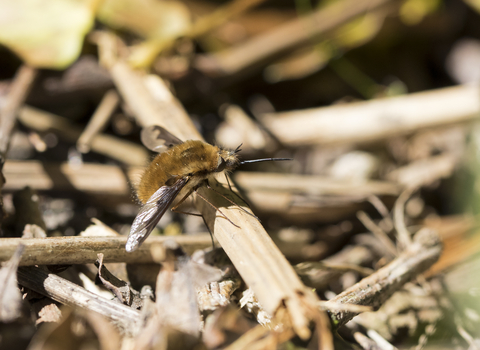
Dark-edged Bee-fly ©Chris Lawrence
Dark-edged bee-fly
Our largest and most common bee-fly, the dark-edged bee-fly looks just like a bumblebee, and buzzes like one too! It feeds on flowers like primroses and violets in gardens, parks and woodlands.
Enw gwyddonol
Bombylius majorPryd i'w gweld
March to MayYnghylch
The dark-edged bee-fly, or 'large bee-fly', looks rather like a bumblebee, with a long, straight proboscis that it uses to feed on nectar from spring flowers, such as primroses and violets. It is on the wing in the early spring, when it can often be seen in sunny patches. In flight, it is even more like a bee as it produces a high-pitched buzz. This species of bee-fly is common, but the heath and mottled bee-flies are much rarer.What to look for
Looking like a bee, the dark-edged bee-fly has yellowy-brown hair on its body, long, spindly legs, and a long proboscis. The wings have dark markings along their leading edges, hence it's common name. There are several species of bee-fly in the UK, which can be very difficult to tell apart; the dark-edged bee-fly has a dark edge to the wings, while others have plainer, translucent wings.Where to find
Widespread.Roeddech chi yn gwybod?
The larvae of the dark-edged bee-fly are nest parasites of ground-nesting and solitary bees, feeding on the bee grubs. The female bee-fly flicks her eggs towards the entrance holes of solitary bee nests to allow the larvae to hatch in the right place. She even coats her eggs with sand, soil, or gravel to protect them, camouflage them, and make them easier to throw!Bee-fly egg flicking (https://vimeo.com/410980790)
© Tom Hibbert
